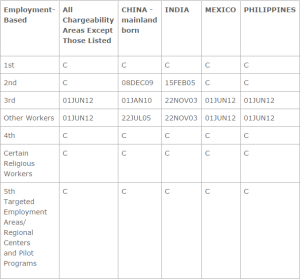11 Nov Understanding Visa Quotas: A Primer
Although some categories of immigrants are generally automatically eligible for a visa when their application is submitted (e.g. immediate relatives of U.S. citizens), many other immigrant categories are subject to annual limits.[1] The US State Department sets these visa quotas at the beginning of each fiscal year, which runs from October 1st to September 30th. These limits are based on the type of visa and the applicant’s place of birth.
If you are interested in applying for a visa, it’s important to understand whether the US government is currently processing your visa category for your region of birth. Backlogs in processing may result in a longer waiting time for your visa. To assist you in better understanding visa quotas, we have put together an easy-to-follow primer which also covers the ways in which you can find out whether your particular application is being processed by the government, or has been put “on hold” for the time being.
Priority Dates
The most important piece of information you need in order to check the status of your visa category is your application’s “Priority Date.” The Priority Date is the date on which your visa petition is filed. It determines your place on the waiting list for the particular visa type. Visa petitions are processed on a first-come/first-served basis, which means that the earlier you submit your application, the sooner it will be processed.[2]
How to Know if Your Visa Category is Current
The US State Department publishes a monthly Visa Bulletin that indicates which visa categories are currently being processed by geographical region.
In the monthly bulletin, some visa categories are marked by a “C” (meaning Current). This signifies that all priority dates for that category and birthplace are eligible for processing. However, if a date is listed instead of a “C,” this means that a cut-off date has been issued. Typically this happens when there are more visa applicants than the State Department can handle. In other words, there is a backlog in terms of processing visa petitions.
A cut-off date can mean good news or bad news, depending upon when your petition was submitted, i.e. your priority date. That is, “If your priority date is before the cut-off date according to the monthly Visa Bulletin, your case is current. This means your immigrant visa case can now be processed.” But, if your priority date falls after the cut-off date, you will need to wait until your priority date is reached (becomes current) for your case to be processed.[3]
Let’s consider two practical examples:
- Lin is a Chinese national seeking an EB-2 visa. If she looks at the most current bulletin as of the writing of this article (November 2014), she will see a cut-off date of “08DEC09” (December 8th, 2009). Luckily, Lin’s priority date is November 22nd, 2009, which is before the current cut-off date for the EB-2 visa category for Chinese-born petitioners. This means that her visa application is eligible for processing.
- Edward is another Chinese EB2 applicant. His visa petition has a priority date of February 15th, 2010, which comes after the cut-off date of December 8th, 2009, as specified in the November 2014 bulletin. This means that his application is not currently being processed. He has to wait until the monthly bulletin issues a cut-off date that is at least one day after February 15th, 2010.
Now that you understand how to read the monthly bulletin, you can check it out here. The bulletin is a few pages long and you will have to scroll down to look for your immigrant category. Luckily, the State Department has created a simple look-up tool, called the “Priority Date Checker,” which can be found here. The “Priority Date Checker” requires your visa category, birth country, and the visa bulletin that is of interest you (simply select the current month for the most up-to-date information). Once you submit this information, you will receive confirmation regarding whether your visa category’s status is “current” for all priority dates, and, if not, it will confirm the “cut-off” date.
Retrogression: A Likely Reality
As explained by the State Department, “Sometimes an immigrant category that is current one month will not be current the next month.” This typically occurs when the annual numerical limit has been reached, usually toward the end of a fiscal year. “When the new fiscal year begins, the Visa Office gets a new supply of visa numbers and usually brings back the cut-off dates to where they were before retrogression.”[4]
For illustration purposes, let’s consider a real-world example. The Department of State issued a retrogression for Chinese EB-5 visa applicants on August 23rd, 2014. This meant that for this group of petitioners, no visa applications were being processed for the remainder of that fiscal year (i.e. until September 30th, 2014). As of October 1st, 2014, the visa category was again current.
Future retrogressions are a likely possibility for some visa applicants. As previously reported on our blog, the U.S. Department of State recently announced a possible retrogression of the EB-5 immigrant visa category to place in July 2015.
Importantly, even if your visa category is no longer available for the current fiscal year, you should still submit a visa petition. Doing this allows you to secure your spot on the waiting list once the visa category becomes current again.[5]
To find out about professional, credible and comprehensive Visa Business Plans as well as a variety of ancillary services, all of which are designed to specifically address USCIS’s concerns, contact e-Council Inc.com at info@ecouncilinc.com.
e-Council Inc.com’s website, newsletter and other forms of communication contain general information about legal matters. The information is not legal advice, and should not be treated as such. You must not rely on the information on this website as an alternative to legal advice from your attorney or other professional legal services provider. If you have any specific questions about any legal matter you should consult your attorney or other professional legal services provider.
[1] http://www.nolo.com/legal-encyclopedia/visa-retrogression-why-is-my-priority-date-no-longer-current.html
[2] http://travel.state.gov/content/visas/english/general/glossary.html#P
[3] http://travel.state.gov/content/visas/english/general/glossary.html#C
[4][4] http://travel.state.gov/content/visas/english/general/glossary.html#R
[5] http://www.eb5insights.com/2014/09/09/u-s-department-of-state-issues-october-visa-bulletin-eb-5-visa-category-current/



